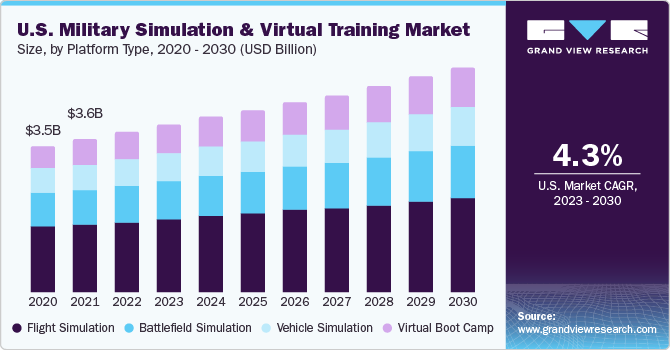Military Simulation and Virtual Training Market Sees Demand in Mission Planning

The global military simulation and virtual training market was valued at USD 13.02 billion in 2022 and is projected to reach USD 18.75 billion by 2030, growing at a compound annual growth rate (CAGR) of 4.7% from 2023 to 2030. This growth is primarily fueled by the increasing need for a skilled workforce in naval operations and the rising demand for both conventional and unconventional military equipment and software.
Traditional real-time military training is not only costly and time-intensive but also requires substantial resources, such as fuel and explosives, with inherent risks. Consequently, defense ministries worldwide are shifting towards virtual training and simulation-based platforms that leverage technologies like Artificial Intelligence (AI), big data, and cloud computing.
Military simulation systems enable the realistic training of recruits by replicating real-time scenarios using advanced software. The rise in investments in simulation technologies and the defense sector's ongoing modernization efforts are expected to further boost the market. Governments are increasingly restructuring their military frameworks using innovative simulation tools, accelerating the adoption of these systems.
Simulations and virtual training programs are gaining widespread adoption among global armed forces due to their cost-effectiveness. These systems are developed using Commercial-off-the-Shelf (COTS) components, which minimize development costs and promote scalable solutions. This, in turn, enables the military to innovate rapidly in simulation-based training.
Moreover, the growing demand for upgrading existing equipment and acquiring new, technologically advanced systems is contributing to the market’s expansion. For instance, Bohemia Interactive Simulation introduced an Augmented Reality (AR) visual system for Textron, Inc., which merges real-world interactions with synthetic environments through VR/AR technologies.
Advancements in portable simulation systems—including vehicle, flight, and battlefield simulations—allow customization for specific missions and applications across air, ground, and naval domains. These tailored systems provide strategic experiential training, enhancing soldier readiness, particularly in managing complex missile systems and electronic military hardware.
As defense budgets are constrained in several countries, governments are seeking cost-effective training alternatives. This trend is expected to further bolster demand for virtual training solutions, as they offer improved capabilities at reduced operational costs.
Order a free sample PDF of the Military Simulation and Virtual Training Market Intelligence Study, published by Grand View Research.
Key Market Trends & Insights:
- North America held the largest revenue share at 34.9% in 2022.
- Air application segment dominated by revenue with a 44.0% share in 2022.
- Ground application segment is expected to grow at the highest CAGR of 4.9% during the forecast period.
- Flight simulation led among platform types, accounting for 39.6% revenue share in 2022.
Market Size & Forecast:
- 2022 Market Size: USD 13.02 Billion
- 2030 Projected Market Size: USD 18.75 Billion
- CAGR (2023–2030): 4.7%
- Leading Region (2022): North America
- Fastest Growing Region: Asia Pacific
Key Players & Market Strategies:
Industry leaders are pursuing strategic acquisitions and partnerships to strengthen their market position. The sector, still evolving, is witnessing an uptick in product launches and contractual agreements. For instance, in November 2022, BAE Systems collaborated with Inzpire to integrate immersive training expertise into its Operational Training Services, aiming to deliver secure, high-fidelity synthetic training environments.
Major Companies in the Market:
- Northrop Grumman
- Cubic Corporation
- CAE Inc.
- AAI Corporation
- Collins Aerospace
- Lockheed Martin Corporation
- BAE Systems
- L3Harris Technologies, Inc.
- Thales
- Bohemia Interactive Simulations
Explore Horizon Databook – The world's most expansive market intelligence platform developed by Grand View Research.
Conclusion:
The military simulation and virtual training market is on a steady growth trajectory, driven by the need for cost-effective, safe, and technologically advanced training methods. With defense forces worldwide seeking innovative ways to enhance operational readiness, investments in simulation-based systems are likely to accelerate. As defense budgets tighten, simulation technologies offer an optimal solution for maintaining combat proficiency while minimizing costs and risk—positioning the market for sustained long-term growth.
- Art
- Causes
- Crafts
- Dance
- Drinks
- Film
- Fitness
- Food
- Games
- Gardening
- Health
- Home
- Literature
- Music
- Networking
- Other
- Party
- Religion
- Shopping
- Sports
- Theater
- Wellness


